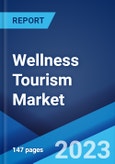The global wellness tourism market size reached US$ 889 Billion in 2022. Looking forward, the publisher expects the market to reach US$ 1,327 Billion by 2028, exhibiting a growth rate (CAGR) of 6.7% during 2023-2028.
Wellness tourism is a lifestyle activity involving numerous trips that help empower and maintain one’s personal wellbeing. It is designed to emphasize authentic experiences and assist the purpose of healthy living, stress reduction, disease prevention, and minimizing poor lifestyle habits. It also aids in enriching the mental as well as physical health of individuals. Wellness tourism provides travel as an opportunity for relaxation and unwinding, the discovery of joy, and self-actualization to the masses. It consists of tours to several places and facilities that serve its purpose, including wellness resorts, wellness spas, hospitals, clinics, and fitness centers, where spa therapies and other wellness activities are provided to ensure customer satisfaction.
Wellness tourism is a lifestyle activity involving numerous trips that help empower and maintain one’s personal wellbeing. It is designed to emphasize authentic experiences and assist the purpose of healthy living, stress reduction, disease prevention, and minimizing poor lifestyle habits. It also aids in enriching the mental as well as physical health of individuals. Wellness tourism provides travel as an opportunity for relaxation and unwinding, the discovery of joy, and self-actualization to the masses. It consists of tours to several places and facilities that serve its purpose, including wellness resorts, wellness spas, hospitals, clinics, and fitness centers, where spa therapies and other wellness activities are provided to ensure customer satisfaction.
Wellness Tourism Market Trends:
The market is primarily driven by a considerable rise in travel and personal wellbeing expenditure. This can be attributed to the inflating disposable income levels of the masses. Besides this, with the increasingly hectic work schedules and sedentary lifestyles resulting in the rising prevalence of various lifestyle diseases among individuals, the growing preference for leading a healthy lifestyle is propelling the market growth. The market is further driven by continual technological advancements, such as convenient flights, hotel and activity bookings, and the ability to compare various available adventure travel options via online platforms. In addition to this, numerous research and development (R&D) activities, mergers and acquisitions (M&A) and partnership strategies by major market players to expand the geographical reach of wellness tourism are creating lucrative growth opportunities in the market. Some of the other factors further contributing to the market growth include rapid urbanization, a significant increase in e-literacy rates, and the increasing influence of social media on the global level.Key Market Segmentation:
The publisher provides an analysis of the key trends in each sub-segment of the global wellness tourism market report, along with forecasts at the global, regional and country level from 2023-2028. The report has categorized the market based on travelers type, service type and location.Breakup by Travelers Type:
- Primary
- Secondary
Breakup by Service Type:
- Transport
- Lodging
- Food and Beverage
- Shopping
- Activities and Excursion
- Others
Breakup by Location:
- Domestic
- International
Breakup by Region:
- North America
- United States
- Canada
- Asia-Pacific
- China
- Japan
- India
- South Korea
- Australia
- Indonesia
- Others
- Europe
- Germany
- France
- United Kingdom
- Italy
- Spain
- Russia
- Others
- Latin America
- Brazil
- Mexico
- Others
- Middle East and Africa
Competitive Landscape:
The competitive landscape of the industry has also been examined along with the profiles of the key players being Accor S.A., Four Seasons Hotels Limited, Hilton Worldwide Holdings Inc., Hyatt Hotels Corporation, InterContinental Hotels Group plc, Marriott International Inc., Radisson Hospitality Inc. (Jin Jiang International Co. Ltd.), Rancho La Puerta Inc., Red Carnation Hotels (The Travel Corporation), Rosewood Hotel Group (New World Development Company Limited) and Wyndham Hotels & Resorts Inc.Key Questions Answered in This Report:
- How has the global wellness tourism market performed so far and how will it perform in the coming years?
- What has been the impact of COVID-19 on the global wellness tourism market?
- What are the key regional markets?
- What is the breakup of the market based on the travelers type?
- What is the breakup of the market based on the service type?
- What is the breakup of the market based on the location?
- What are the various stages in the value chain of the industry?
- What are the key driving factors and challenges in the industry?
- What is the structure of the global wellness tourism market and who are the key players?
- What is the degree of competition in the industry?
Table of Contents
1 Preface3 Executive Summary11 Value Chain Analysis13 Price Analysis
2 Scope and Methodology
4 Introduction
5 Global Wellness Tourism Market
6 Market Breakup by Travelers Type
7 Market Breakup by Service Type
8 Market Breakup by Location
9 Market Breakup by Region
10 SWOT Analysis
12 Porters Five Forces Analysis
14 Competitive Landscape
Companies Mentioned
- Accor S.A.
- Four Seasons Hotels Limited
- Hilton Worldwide Holdings Inc.
- Hyatt Hotels Corporation
- InterContinental Hotels Group plc
- Marriott International Inc.
- Radisson Hospitality Inc. (Jin Jiang International Co. Ltd.)
- Rancho La Puerta Inc.
- Red Carnation Hotels (The Travel Corporation)
- Rosewood Hotel Group (New World Development Company Limited)
- Wyndham Hotels & Resorts Inc.
Methodology

LOADING...
Table Information
| Report Attribute | Details |
|---|---|
| No. of Pages | 147 |
| Published | September 2023 |
| Forecast Period | 2022 - 2028 |
| Estimated Market Value ( USD | $ 889 Billion |
| Forecasted Market Value ( USD | $ 1327 Billion |
| Compound Annual Growth Rate | 6.9% |
| Regions Covered | Global |
| No. of Companies Mentioned | 11 |









